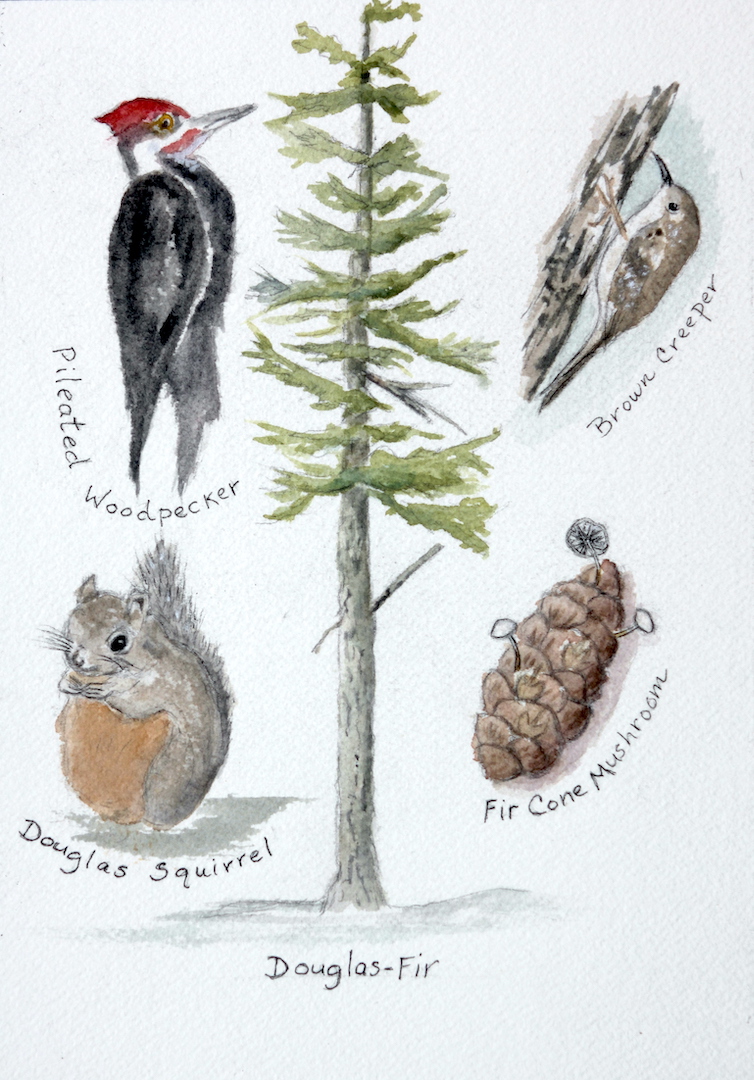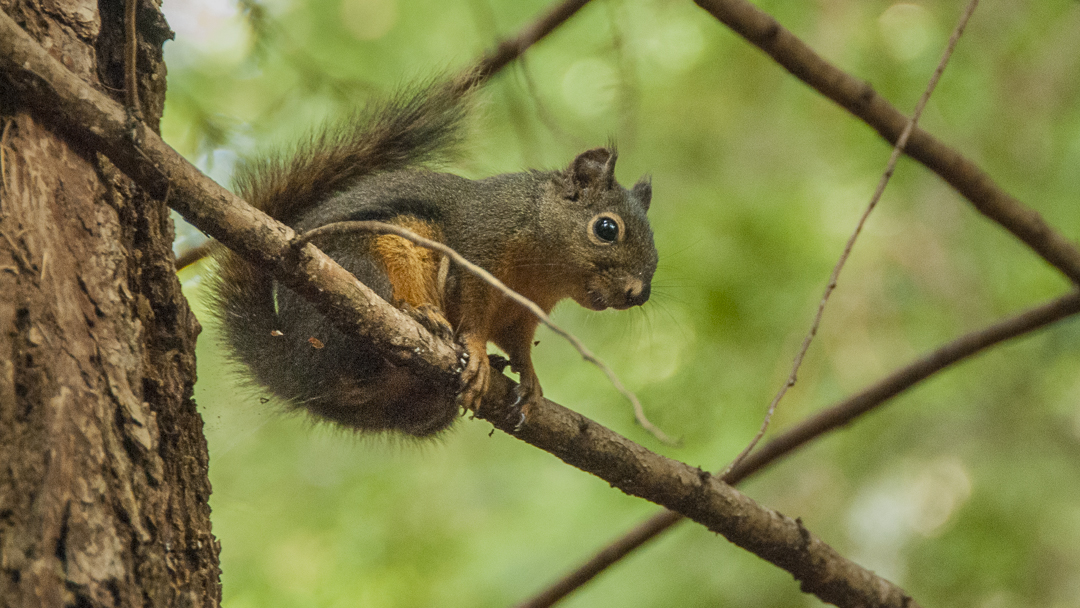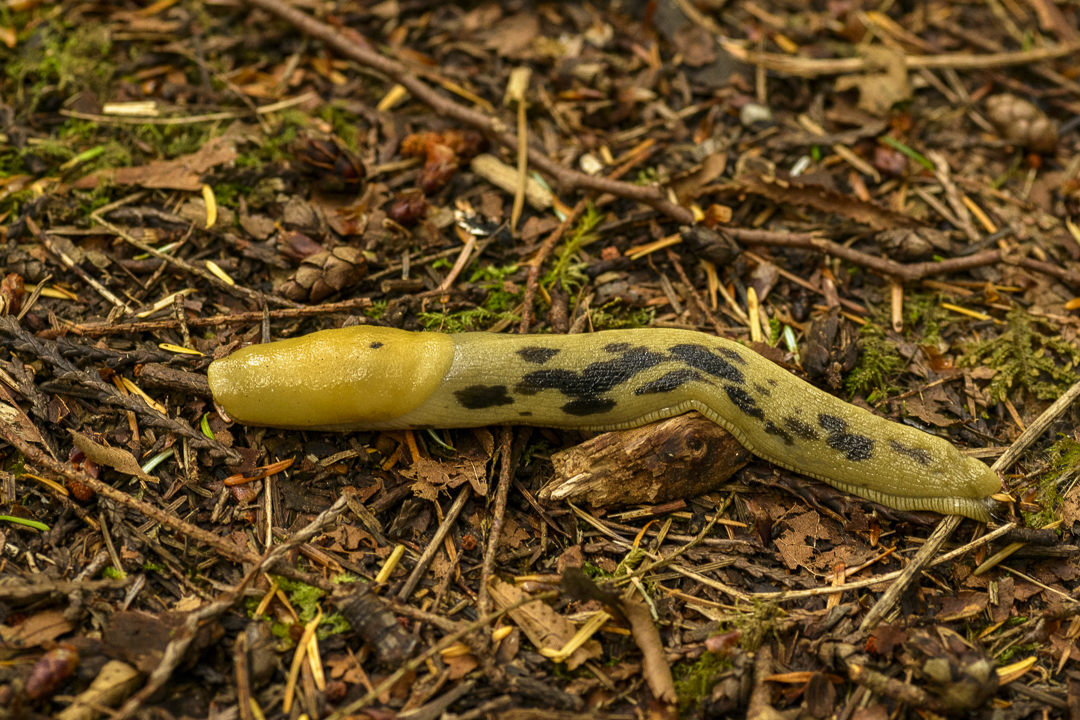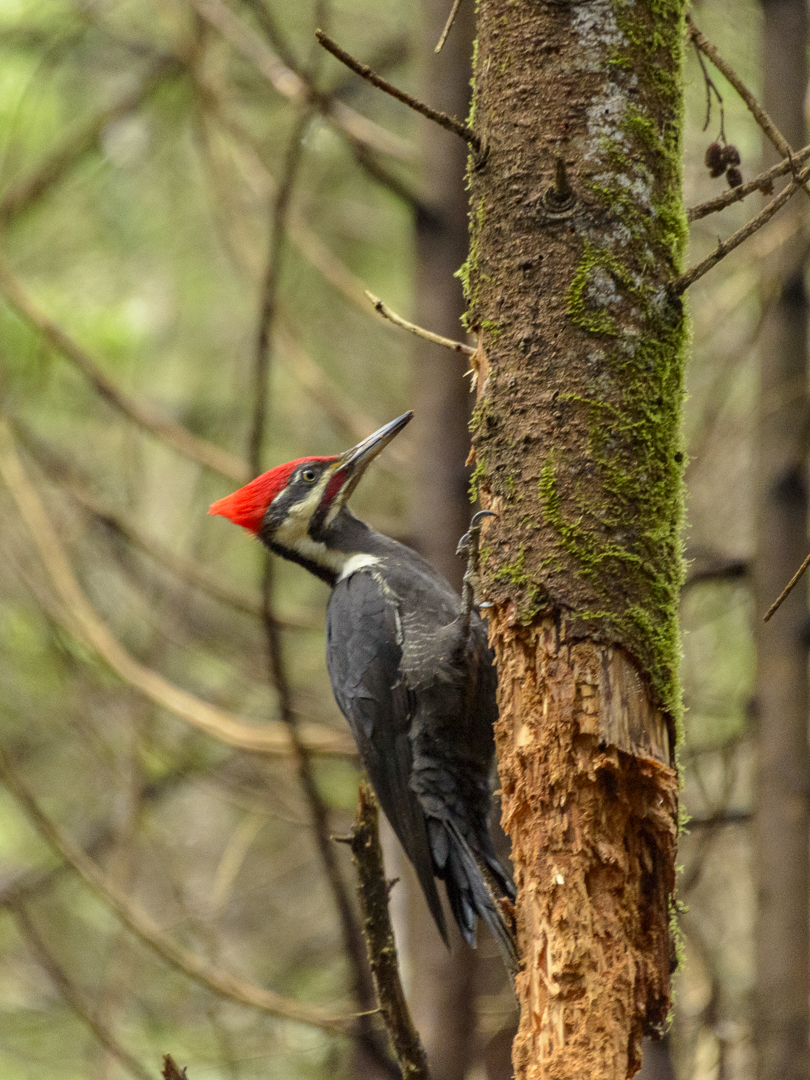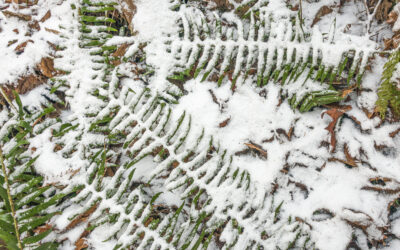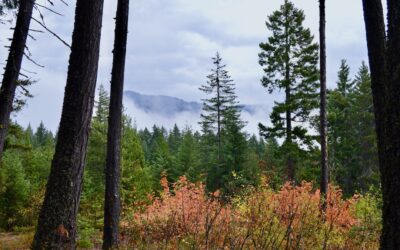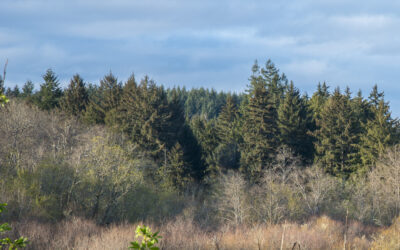Seeing Beyond the Trees
by Mary Johnson, Winter 2023
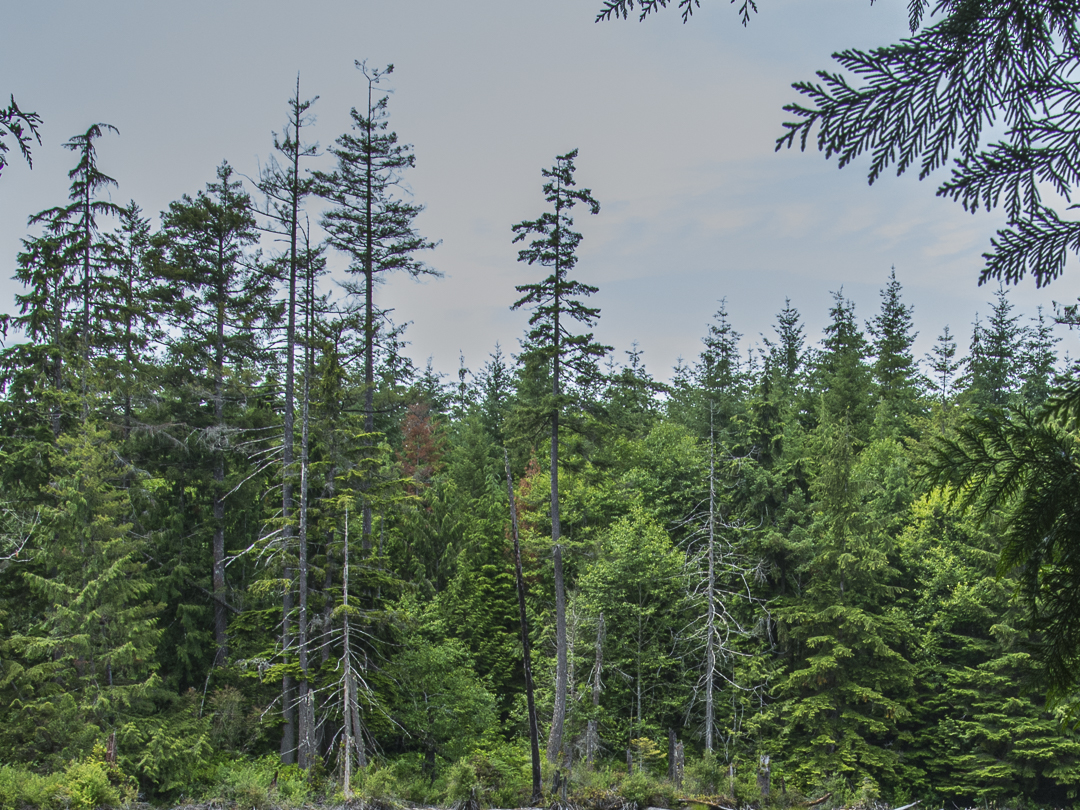
Evergreens in Newberry Hill Heritage Park, Silverdale, WA. photo by John F. Williams
Seeing Beyond the Trees
by Mary Johnson
Winter 2023
Evergreen trees, particularly the Douglas-fir (Pseudotsuga menziesii) tree, dominate the botanical landscape on the western side of Washington State. Walking beneath their sweeping canopies is an iconic aspect of living among the lowland forests of the Salish Sea area. But there is more to our forests than merely majestic stands of Douglas-fir and other trees. If we look more closely, we’ll discover a community of wildlife — that often goes unnoticed — that depends on these trees for food and shelter.
Let’s ramble through a forest and explore some of these species we’re likely to see wherever we find Douglas-fir trees: the Douglas squirrel (Tamiasciurus douglasii), the fir cone mushroom (Strobilurus trullisatus), the pileated woodpecker (Dryocopus pileatus), and the brown creeper (Certhia americana).
The trail is dry and hard-packed as we set out on a warm late-summer day. The soaking rains of autumn have yet to arrive, and as we walk our hiking shoes kick up mini clouds of dust, which coat the upper reaches of our socks and the bottom of our pant legs. The many different species of mosses clinging to the rocks and the earth, so plump with moisture just a few weeks ago, now lie pale and shriveled from the dry days of summer. There is a comfortable and peaceful silence to the forest that draws us in as we walk among the trees: the Douglas-fir, western red cedar (Thuja plicata), western hemlock (Tsuga heterophylla), big-leaf maple (Acer macrophyllum), and others that make up our forests near the Salish Sea.
Then, breaking the silence: plop, plop, plink! Speeding projectiles are cascading from the sky, barely missing our heads, as we walk under a Douglas-fir tree. We pick up the pace, trying to navigate around these unidentified objects. Stopping ahead, we turn to look back and up — way up — into the tree. There, perched on a limb, peering down on us, we catch a glimpse of a Douglas squirrel chattering away, as if scolding us, the intruders to its forest home.
While we’ve been recreating leisurely along the trail, our native tree squirrel, rusty-colored on its underside, brownish-gray on its back, and with a whitish ring around its eye, has been busily harvesting the Douglas-fir cones. This energetic creature doesn’t waste time searching for cones on the ground. Instead, it cleverly snips the pendant cones (the aforementioned speeding projectiles) from high in the branches, dropping them to the ground. Then the squirrel builds a larder, kind of like stocking a kitchen pantry. It collects the cones, which contain dozens of ripening seeds, in a tree hollow or buries them underground. Within these damp environments, the cones stay fresh and refrigerated for the squirrel’s future meals.
When the squirrel retrieves the cones, it peels off the scales to reach the nutritious seeds, often doing this while sitting in one place, perhaps on a lower limb. The discarded scales and leftover husks of cones, which now resemble little stripped cobs of corn, accumulate at the base of the Douglas-fir into piles (sometimes huge piles) called middens, the tell-tale results of its industrious work.
Of the collected cones, the Douglas squirrel retrieves perhaps a small percentage of them. Most are misplaced or forgotten. This means that the seeds are dispersed, and if they eventually sprout, the squirrel becomes an unintentional planter of Douglas-fir trees.
Continuing our ramble, we walk our way into autumn, just a few weeks later. Rainfall is becoming abundant now; the trail is a bit slick in places. The big-leaf maples and other deciduous trees and the understory shrubs are taking on color, and tiny droplets of dew cling to their leaves, sparkling against the low-angled rays of the sun. The mosses are once again verdant and lush. It’s the time of the mushroom. Everywhere we look, we see so many different species, spilling recklessly from decaying logs and sprouting upright, alone or in groups, among the scattered leaves on the ground.
We pause beneath the canopy of a Douglas-fir to admire this fungal scene. Our eyes are drawn downward to what look like, from our vantage point above, random dots of white on a fallen Douglas-fir cone. Our curiosity is now piqued; we bend down to examine our find.
There, peeking out from among the scales of the fallen cone that escaped the grasp of the Douglas squirrel, we see the small, delicate, fruiting bodies of the fir-cone mushroom, one of the earliest mushrooms to fruit in autumn. This gilled mushroom, which typically inhabits Douglas-fir cones that are fairly well rotted, sports a whitish convex (sometimes flat) cap and a slim stem, yellowish at the base and fading to white near the cap. Though the fir-cone mushroom is just one of the many, many species of fungi associated with the Douglas-fir tree, it’s the one species we’re most likely to encounter in association with this tree. For its entire life, this mushroom dwells on the Douglas-fir cone, its sole purpose being to break down the cone’s nutrients, which will be returned eventually to the earth.
Before walking on, we take another close look at the diminutive fir-cone mushrooms nestled in the cone, and then we gaze upward at the huge Douglas-fir towering above us, easily over 100-feet tall. We try to wrap our human minds around the immense difference in size between these two organisms and how they came to be so inextricably linked in nature.
We now walk our way into spring, a time when the forest bursts with movement, color, and sound. We tread carefully along the trail, stepping around a Pacific banana slug (Ariolimax columbianus) and then an Oregon forestsnail (Allogona townsendiana) as they slowly creep across the earth. The trail is edged with carpets of wildflowers. We take a moment to admire the bluish-green, fern-like foliage of the Pacific bleeding heart (Dicentra formosa), ornamented with puffy, pink blossoms. We take in the backdrop of the dense thickets of salmonberry (Rubus spectabilis), whose overarching branches are replete with striking magenta blossoms that will eventually transform into orangey-red berries, an important food for a variety of wildlife.
Our senses are alert to the sounds of bird activity as territories are claimed and defended, and breeding and nesting gets underway. Catching our immediate attention is an emphatic staccato drumming echoing through the trees. In the standing dead wood of a Douglas-fir tree, we see the sound’s source: a pileated woodpecker. Everything about this bird’s presence and behavior seems to say, “Look at me.”
Mostly black with a heavy bill and a long neck, this crow-sized bird is our largest woodpecker. Its distinctive red tufted cap toward the back of the head is impossible to miss as we watch and listen to the bird repeatedly drum, a sound that can be heard up to a half mile away.
Suddenly it takes flight over us, and we catch a glimpse of the large patches of white on the underwing. The pileated woodpecker lands on another nearby Douglas-fir snag, letting loose a series of loud, clear piping calls, that sound almost prehistoric. Much of the snag is already covered with its signature rectangular-shaped holes. We watch as the bird, using its bill like a chisel, sets to work enlarging one of those cavities. Wood chips fly in every direction as it whacks away, probing for ants, beetles, and other insects. Holes like these, that now offer a food source for the pileated woodpecker, may eventually become future nesting cavities for an owl or another bird that needs a home.
We walk on; up ahead we catch the slightest bit of movement on the trunk of a Douglas-fir. A small, brownish bird is making its way up the thick trunk. In quick, jerky movements, it appears first on one side of the trunk, then spirals around to the other side, momentarily disappearing. Suddenly it pops back into view, hitches up the trunk a bit more, probing under the bark, and then flutters down, like a leaf, to the bottom, to restart again. Then just as quickly, it’s off, flying low to the bottom of another nearby Douglas-fir, where we lose sight of it completely.
Viewing this scant minute’s worth of the brown creeper on a foraging expedition captivates us. Unlike the pileated woodpecker’s flamboyant looks and ways, it’s almost as if the brown creeper doesn’t want to be seen. Though not an uncommon bird, when motionless, it’s easy to overlook — a mere 5-inch speck on a towering trunk clinging with its long, curved claws. The cryptical coloring of the bird’s plumage heightens this association, providing effective camouflage. Its upper parts are a various mottling of browns and tans with lighter-colored spotting, resembling, as some have described, a piece of tree bark. The bird’s underparts are buffy white. Its long, slender bill is perfectly shaped into a downward curve to probe for and extract the ants, spiders, and other insects that live in the deeply furrowed bark of mature Douglas-fir trees. The stiff feathers of its long tail support the bird as it creeps up—almost never down—the tree. Even detecting its call — high-pitched, thin, and piercing — requires one’s hearing to be keen. A weak flyer, this bird mainly exists, unobtrusively, in the vertical world of tree trunks. It even tucks its inconspicuous nests behind a loose flap or shard of bark.
Hazel Wolf, the activist and environmentalist, said: “I saw that little brown creeper, and I knew that bird. It worked hard for a living, and so did I. It had a lifestyle, always up the tree, just like I had a lifestyle — get up in the morning, eat breakfast, catch a bus, and go to work, eat lunch and go back to work, come home at night. I related to that bird.”*
The brown creeper, Douglas squirrel, fir cone mushroom, and pileated woodpecker are all working hard for a living, relying on their relationships with the Douglas-fir tree and other elements of the forest to survive.
Take your own walk in the forest and discover these organisms, as well as new ones, for yourself. With each step you take on the trail, you can learn more about the space that surrounds you and explore the community of life that exists in and around the trees.
*Starbuck, S. (2002). Hazel Wolf: Fighting the Establishment. University of Washington Press.

Mary Johnson is a former technical writer and editor who now writes stories about paying attention to the natural world. She has lived in the Pacific Northwest for over 30 years and has walked miles and miles of trails beneath the Douglas-firs.
Table of Contents, Issue #22, Winter 2023
Gardening With Native Evergreen Plants
by John Bolivar, Winter 2023 Snow on sword ferns. photo by John F. Williamsby John Bolivar Winter 2023The cold winter months here in the Pacific Northwest can be a lonely time — especially if some of your best friends are flowers. I start to miss my colorful...
Magic of Evergreens
by Sarah Ottino, Winter 2023 Landscape showing the contrast between evergreens and colored deciduous leaves. photo by Sarah Ottinoby Sarah Ottino Winter 2023For many, the term “evergreen” invokes images of fir-covered hills veiled in misty clouds or nostalgic...
Poetry 22
by multiple poets, Winter 2023 Bare deciduous trees and evergreen trees. photo by John F. Williamsby multiple poets Winter 2023Dependable Green by Ælfhild Astrædottir Green is the call sign of summerWhen chlorophyll works overtimeGathering in wavelengths of...
PLEASE HELP SUPPORT
SALISH MAGAZINE
DONATE
Salish Magazine contains no advertising and is free. Your donation is one big way you can help us inspire people with stories about things that they can see outdoors in our Salish Sea region.
We also don't advertise Salish Magazine, so please spread the word of this online resource to your friends and colleagues.
Thanks so much for your interest and your support.
We also don't advertise Salish Magazine, so please spread the word of this online resource to your friends and colleagues.
Thanks so much for your interest and your support.

